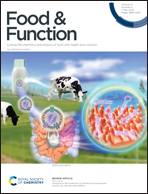Texture properties of foods targeted for individuals with limited oral processing capabilities: the elderly, dysphagia, and head and neck cancer patients
Abstract
Food texture remains a key sensory attribute for food enjoyment, with the potential to modulate food intake, particularly in individuals with limited oral processing capabilities (OPC) such as the elderly, dysphagia, and head and neck cancer (HNC) patients. However, information relating to the textural quality of foods for these consumers is limited. Unsuitable food textures can cause food aspiration, lower meal enjoyment, reduce food/nutrient intake, and potentially lead to malnutrition. The objective of this review was to critically examine the state-of-the-art scientific literature on the textural properties of foods for individuals with limited OPC, identify existing gaps in research, and appraise the rheological-sensory textural design of optimal foods for individuals with limited OPC to improve eating safety, food intake, and nutritional status. Depending on the food type and nature of oral hypofunction, many foods for individuals with limited OPC have very low or too high viscosity, with low cohesiveness and high values for hardness, thickness, firmness, adhesiveness, stickiness, and slipperiness. Fragmented stakeholder approaches, the non-Newtonian nature of foods, the complexity of in vivo, objective food oral processing evaluation, suboptimal application of sensory science and psycho rheology, and research methodological weaknesses are some of the obstacles to addressing texture-related dietary challenges for individuals with limited OPC. There is a need to explore various multidisciplinary strategies for food texture optimization and interventions to improve food intake and nutritional status amongst people with limited OPC.

- This article is part of the themed collections: Food & Function Review Articles 2023 and Food structure, sensory perception, and nutrition


 Please wait while we load your content...
Please wait while we load your content...